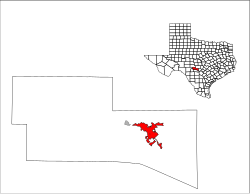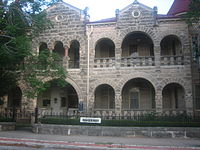Kerrville, Texas
Kerrville, Texas | |
|---|---|
 Kerrville around 1900 | |
 Location of Kerrville, Texas | |
| Country | |
| State | |
| County | Kerr |
| Government | |
| • Type | Council-Manager |
| • City Council | Mayor David Wampler Scott Gross Bruce Motheral Gene Allen Stacie Keeble Pat McGrail |
| • City Manager | Todd Parton |
| Area | |
| • Total | 16.9 sq mi (43.9 km2) |
| • Land | 16.7 sq mi (43.3 km2) |
| • Water | 0.2 sq mi (0.6 km2) |
| Elevation | 1,637 ft (499 m) |
| Population (2000) | |
| • Total | 20,425 |
| • Density | 1,222.5/sq mi (472.0/km2) |
| Time zone | UTC-6 (Central (CST)) |
| • Summer (DST) | UTC-5 (CDT) |
| ZIP codes | 78028-78029 |
| Area code | 830 |
| FIPS code | 48-39040Template:GR |
| GNIS feature ID | 1339058Template:GR |
| Website | Kerrville.org |



Kerrville is a city in Kerr County, Texas, United States.Template:GR The population was 20,425 at the 2000 census. In 2009, the population was 22,826.[1] Kerrville is named after James Kerr, a major in the Texas Revolution, and friend of settler-founder Joshua Brown, who settled in the area to start a shingle-making camp.[2]
Being nestled in the hills of Texas Hill Country, Kerrville is best known for its beautiful parks that line the Guadalupe River - which runs directly through the city, its nearby youth summer camps, hunting ranches, and RV parks. It's also the home of Texas' Official State Arts & Crafts Fair, the Kerrville Folk Festival, H-E-B Grocery Stores, Mooney Airplane Company,[3] James Avery Jewelry, Kerrville Bus Company,[4] and Schreiner University. The Museum of Western Art (founded 1983) features the work of living artists specializing in the themes of the American West.
History
Archeological evidence suggests that humans dwelled in the area known as Kerrville as early as 10,000 years ago. The early modern residents were successful shinglemakers whose mercantile business became a hub that served the middle and upper Hill Country area in the late 1840s. One of the earliest shinglemakers was Joshua D. Brown. With his family, Joshua Brown had led several other families on an exploration of the Guadalupe Valley. These early pioneers organized their settlements near a bluff just north of the Guadalupe River in the eastern half today's county line. The settlement was referred to as "Brownsborough," but after the area was formally platted in 1856 by James Kerr, a major in the Texas Revolution, the settlement was formally known as "Kerrville" and maintained a county seat with Texas.
Starting in 1857, a German master-miller named Christian Dietert and millwright Balthasar Lich started a large grist and saw mill on the bluff. This mill established a permanent source of power and protection from floods, and became the most extensive operation of its kind in the Hill Country area west of New Braunfels and San Antonio. Soon afterwards, Charles A. Schreiner rode Kerrville's newly-found popularity, by serving Kerrville's mercantile needs. Schreiner established a family-run empire that helped build Kerrville's early prosperity by owning almost all of Kerrville's business sectors, including freighting enterprises, retail, wholesale, banking, ranching, marketing, and brokering operations. Schreiner's elegant downtown home, a Romaneque stone structure at 226 Earl Garrett Street, is the site of the Hill Country Museum in downtown Kerrville.
The Civil War slowed Kerrville's development, but with the start of The Reconstruction Era, Kerrville's economic boom and ethnic diversification continued anew as demand grew in San Antonio for lumber, produce, and craftsmen. Kerrville's boom was also catalyzed by the combination the cessation of Indian raids and the expansion into the business of cattle, sheep, and goat ranching. Cattle drives punctuated the boom-years of the late 1880s and the 1890s. In 1887, the San Antonio and Aransas Pass Railway reached Kerrville, and in 1889 the town incorporated, with an "Aldermanic" form of city government.
The Kerrville Water Works Company began to provide water for town dwellers in 1894. Telephone service was introduced in 1896, and the city began to pave streets in 1912. Kerrville adopted a "commission" form of city government in 1917, then changed to the "city-manager" form in 1928. In 1942 the town adopted a home-rule charter, while continuing with a city manager. Kerrville has displayed steady population growth throughout the twentieth century, increasing from 1,423 residents in 1900 to 2,353 in 1920, 5,572 in 1940, 8,901 in 1960, and 15,276 in 1980. Its economic base has diversified and broadened through business, agriculture, light manufacturing, health care, transportation, services, education, the arts, and tourism. By the mid-1990s the Wall Street Journal described Kerrville as one of the wealthiest small towns in America. By 1995 the city's official population was still under 18,000, with another 20,000 people in relatively affluent residential areas south of the river and in the rest of the county. In 2000 the population reached 20,425. Much of the growth in population included retirees and young professionals and semiprofessionals; for many years Kerrville also experienced significant out-migration of young adults raised in the area.
Geography

Kerrville is located at 30°02′47″N 99°8′26″W / 30.04639°N 99.14056°W.Template:GR This is 58 miles (93 km) northwest of San Antonio and 85 miles (137 km) west of Austin.
According to the United States Census Bureau, the city has a total area of 67 km km2 (16.9 sq mi). 16.7 square miles (43.3 km2) of it is land and 0.2 square miles (0.6 km2) of it (1.36%) is water.
Demographics

As of the censusTemplate:GR of 2000, there were 20,425 people, 8,563 households, and 5,411 families residing in the city. The population density was 1,222.5 people per square mile (471.9/km2). There were 9,477 housing units at an average density of 567.2 per square mile (219.0/km2). The racial makeup of the city was 85.89% White, 2.99% African American, 0.55% Native American, 0.57% Asian, 0.08% Pacific Islander, 8.20% from other races, and 1.73% from two or more races. Hispanic or Latino of any race were 22.73% of the population.
There were 8,563 households out of which 8.9% had children under the age of 18 living with them, 49.8% were married couples living together, 10.2% had a female householder with no husband present, and 36.8% were non-families. 33.1% of all households were made up of individuals and 19.4% had someone living alone who was 65 years of age or older. The average household size was 2.21 and the average family size was 2.79.
In the city the population was spread out with 21.0% under the age of 18, 8.0% from 18 to 24, 21.3% from 25 to 44, 20.4% from 45 to 64, and 29.3% who were 65 years of age or older. The median age was 45 years. For every 100 females there were 87 males. For every 100 females age 18 and over, there were 83.0 males.[5]
The median income for a household in the city was $32,085, and the median income for a family was $38,979. Males had a median income of $27,555 versus $19,923 for females. The per capita income for the city was $20,193. About 11.7% of families and 15.6% of the population were below the poverty line, including 25.8% of those under age 18 and 7.8% of those age 65 or over.[5]
Transportation
Interstates
State Highways
 SH 16 (Medina Highway, Sidney Baker Highway, Fredericksburg Road)
SH 16 (Medina Highway, Sidney Baker Highway, Fredericksburg Road) SH 27 (Junction Highway, Main Street, Broadway Avenue)
SH 27 (Junction Highway, Main Street, Broadway Avenue) SH 173 (Bandera Highway)
SH 173 (Bandera Highway)
Loops
 Loop 534 (Veterans Highway)
Loop 534 (Veterans Highway)
Farm to Market Roads
Bicycle Routes
Adventure Cycling Association Southern Tier Bicycle Route[6]
Events
Kerrville is home to the annual Texas State Arts and Crafts Fair which features artisans and entertainers from around the state.[7] Kerrville also plays host to the Kerrville Folk Festival, an annual summer festival which features folk musicians from around the country.[8] The Texas Lions Camp and Echo Hill Ranch Summer Camp are also located in Kerrville.
Education
Kerrville is served by the Kerrville Independent School District, which maintains four elementary schools (Tally, Nimitz, Starkey, and Daniels), two middle schools (BT Wilson 6th Grade & Peterson), and two high schools (Hill Country High School and Tivy High School").[9] Our Lady of the Hills Catholic High School[10] and Notre Dame Catholic School[11] are also located in Kerrville, serving as the primary alternative to the public school system.
Kerrville is home to Schreiner University, a private 4-year college university which was established in 1923 by an ex-Texas Ranger, Captain Charles Schreiner. The school is consistently listed as one of the top regional liberal arts colleges in the Western U.S. by U.S. News & World Report's America's Best Colleges Guide.[12] Schreiner University is also home to Greystone Preparatory School. Greystone offers a one year preparatory course to help individuals prepare for an appointment to one of the five federal service academies.[13]
Notable residents
Sports
- Mike Dyal - Former pro-football player for the Oakland Raiders from 1989 to 1990.[14]
- William Fifer - Former pro-football player for the Detroit Lions in 1978.[15]
- Harvey Hilderbran - Republican state representative from Kerr County since 1989
- John Mahaffey - Pro-golfer who won the 1978 PGA Championship.[16]
- Jesse Stokes - Former pro-football player for the Denver Broncos in 1968.[17]
- John Teltschik - Former pro-football player for the Philadelphia Eagles from 1986 to 1990.[18]
- Gary Phillips - former NBA player for the Boston Celtics (won NBA championship 1960) and Golden State Warriors. Played with Wilt Chamberlain and Bill Russell. NCAA 1st team All American, University Of Houston.
Entertainment
- Alexandra Underwood - Wihelmina Model and contestant of America's Next Top Model
- Thomas Hayden Church - Actor (George of the Jungle, Sideways, Spider-Man 3).[citation needed]
- Robert Earl Keen - Singer and song writer.[19]
- Jimmie Rodgers - "The Father of Country Music" called Kerrville home for his family when he moved them here in 1929.[20][21]
- Stacy Sutherland - Guitarist for the 13th Floor Elevators. Buried in Center Point Cemetery.[22][23]
- John Ike Walton - Drummer for the 13th Floor Elevators.[22]
- Ace Reid - Cowpokes Cartoons. Artist and humorist. Lived in Kerrville from the early 1950s until his death in 1991.[24]
Business
- James Avery - Jeweler and owner of James Avery Jewelers (founded in 1954).[25]
- Florence Butt - Founder of H-E-B Grocery Stores in 1905.[26]
- Hossein "Hagi" Hagigholam - Owner and founder of Mamacita's Mexican Food Restaurants (founded in 1985).[27][28]
Others
- Lou Halsell Rodenberger - Texas author; lived in Kerrville in the 1940s when she was a journalist for the Kerrville Times.[29]
- Jefferson W. Speck, Arkansas politician
Points of interest
References
- ^ Kerrville at City-Data
- ^ [1]
- ^ http://www.mooney.com/about-us/company-facts.html
- ^ http://www.iridekbc.com/about.asp
- ^ a b http://censtats.census.gov/data/TX/1604839040.pdf
- ^ http://www.adventurecycling.org/routes/southerntier.cfm?pg=detail&s=4
- ^ http://www.wintertexansonline.com/state_arts_crafts_fair.htm
- ^ http://www.kerrville-music.com/
- ^ About Kerrville ISD
- ^ Our Lady of the Hills Catholic High School
- ^ Notre Dame Catholic School
- ^ http://colleges.usnews.rankingsandreviews.com/college/items/3610
- ^ http://www.greystoneprepschool.net/
- ^ databaseFootball - Mike Dyal
- ^ databaseFootball - William Fifer
- ^ Mahaffey Takes Southwestern
- ^ databaseFootball - Jesse Stokes
- ^ databaseFootball - John Teltschik
- ^ http://www.myspace.com/robertearlkeen
- ^ Bio-drama and 'blue yodeling'
- ^ Sony Music - Jimmie Rodgers Biography
- ^ a b http://en.wikipedia.org/wiki/13th_Floor_Elevators
- ^ http://en.wikipedia.org/wiki/Center_Point,_Texas
- ^ *Asa Elmer (Ace) Reid, Jr. (1925-1991) at Handbook of Texas OnLine]
- ^ James Avery Jewelers - About James Avery
- ^ H-E-B History
- ^ http://www.schreiner.edu/scene/hagi.html
- ^ http://www.mamacitas.com/index.html
- ^ Lou H. Rodenberger (1926 - 2009)

